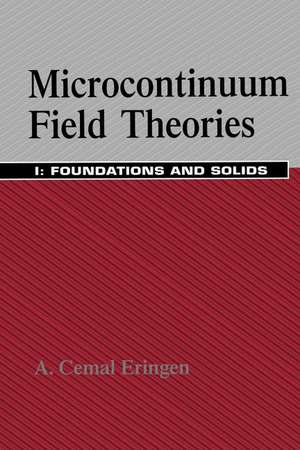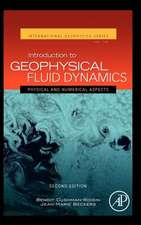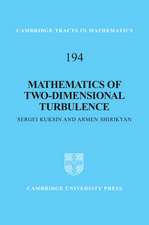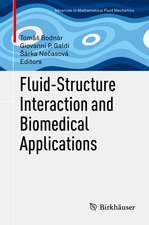Microcontinuum Field Theories: I. Foundations and Solids
Autor A. Cemal Eringenen Limba Engleză Paperback – 27 sep 2012
| Toate formatele și edițiile | Preț | Express |
|---|---|---|
| Paperback (2) | 947.50 lei 6-8 săpt. | |
| Springer – 30 noi 2010 | 947.50 lei 6-8 săpt. | |
| Springer – 27 sep 2012 | 1656.29 lei 6-8 săpt. | |
| Hardback (2) | 951.47 lei 6-8 săpt. | |
| Springer – 29 mar 2001 | 951.47 lei 6-8 săpt. | |
| Springer – 3 iun 1999 | 1550.16 lei 6-8 săpt. |
Preț: 1656.29 lei
Preț vechi: 2019.86 lei
-18% Nou
Puncte Express: 2484
Preț estimativ în valută:
316.97€ • 327.45$ • 263.80£
316.97€ • 327.45$ • 263.80£
Carte tipărită la comandă
Livrare economică 25 martie-08 aprilie
Preluare comenzi: 021 569.72.76
Specificații
ISBN-13: 9781461268154
ISBN-10: 146126815X
Pagini: 344
Ilustrații: XVI, 325 p.
Dimensiuni: 155 x 235 x 18 mm
Greutate: 0.53 kg
Ediția:Softcover reprint of the original 1st ed. 1999
Editura: Springer
Colecția Springer
Locul publicării:New York, NY, United States
ISBN-10: 146126815X
Pagini: 344
Ilustrații: XVI, 325 p.
Dimensiuni: 155 x 235 x 18 mm
Greutate: 0.53 kg
Ediția:Softcover reprint of the original 1st ed. 1999
Editura: Springer
Colecția Springer
Locul publicării:New York, NY, United States
Public țintă
ResearchDescriere
Microcontinuum field theories constitute an extension of classical field theories -- of elastic bodies, deformations, electromagnetism, and the like -- to microscopic spaces and short time scales. Material bodies are here viewed as collections of large numbers of deformable particles, much as each volume element of a fluid in statistical mechanics is viewed as consisting of a large number of small particles for which statistical laws are valid. Classical continuum theories are valid when the characteristic length associated with external forces or stimuli is much larger than any internal scale of the body under consideration. When the characteristic lengths are comparable, however, the response of the individual constituents becomes important, for example, in considering the fluid or elastic properties of blood, porous media, polymers, liquid crystals, slurries, and composite materials. This volume is concerned with the kinematics of microcontinua. It begins with a discussion of strain, stress tensors, balance laws, and constitutive equations, and then discusses applications of the fundamental ideas to the theory of elasticity.
Cuprins
1 Kinematics.- 1.0 Scope.- 1.1 Physical Picture.- 1.2 Motions and Deformations.- 1.3 Rotation.- 1.4 Microstretch and Micropolar Continua.- 1.5 Strain Measures.- 1.6 Relative Motion, Relative Strain Measures.- 1.7 Compatibility Conditions.- 1.8 Material Time-Rate of Tensors.- 1.9 Objective Tensors.- 1.10 Mass, Inertia, Momenta, Kinetic Energy.- 1 Problems.- 2 Stress.- 2.0 Scope.- 2.1 Balance of Energy.- 2.2 Balance Laws.- 2.3 Second Law of Thermodynamics.- 2.4 Dissipation Potential.- 2 Problems.- 3 Constitutive Equations.- 3.0 Scope.- 3.1 Constitutive Equations of Elastic Solids.- 3.2 Constitutive Equations of Fluids.- 3.3 Thermodynamic Restrictions on Solids.- 3.4 Thermodynamic Restrictions on Fluids.- 3.5 Thermodynamic Restrictions on.- Memory-Dependent Solids.- 3.6 Thermodynamic Restrictions on.- Memory-Dependent Fluids.- 3 Problems.- 4 Electromagnetic Interactions.- 4.0 Scope.- 4.1 Balance Laws.- 4.2 Constitutive Equations of E-M Solids.- 4.3 Constitutive Equations of E-M Fluids.- 4.4 Memory-Dependent E-M Solids.- 4.5 Memory-Dependent E-M Fluids.- 4 Problems.- 5 Theory of Micropolar Elasticity.- 5.0 Scope.- 5.1 Linear Constitutive Equations.- 5.2 Material Symmetry and Stability.- 5.3 Isotropic Solids.- 5.4 Formulation of Problems in Micropolar Elasticity.- 5.5 Mixed Boundary-Initial Value Problems in Linear Theory.- 5.6 Curvilinear Coordinates.- 5.7 Uniqueness Theorem.- 5.8 Reciprocal Theorem.- 5.9 Variational Principles.- 5.10 Conservation Laws.- 5.11 Plane Harmonic Waves.- 5.12 Material Moduli.- 5.13 Experimental Attempts.- 5.14 Displacement Potentials.- 5.15 Micropolar Waves in Half-Space.- 5.16 Micropolar Surface Waves.- 5.17 Micropolar Waves in Plates.- 5.18 Fundamental Solutions.- 5.19 Problems of Sphere and Spherical Cavity.- 5.20 Axisymmetric Problems.- 5.21 Penny-Shaped Crack.- 5.22 Stress Distribution Around an Elliptic Hole.- 5.23 Stress Concentration Around a Circular Hole.- 5.24 Nonlinear Waves.- 5.25 Fundamental Solutions in Micropolar Elastostatics.- 5.26 Dislocations and Disclinations.- 5.27 Theory of Micropolar Plates.- 5.28 Flexural Waves.- 5.29 Other Contributions.- 5 Problems.- 6 Microstretch Elasticity.- 6.0 Scope.- 6.1 Linear Constitutive Equations.- 6.2 Uniqueness Theorem.- 6.3 Plane Harmonic Microstretch Waves.- 6.4 A Lattice Model for Microstretch Continuum.- 6.5 Fundamental Solutions.- 6.6 Microstretch Surface Waves.- 6.7 Other Solutions.- 6 Problems.- 7 Micromorphic Elasticity.- 7.0 Scope.- 7.1 Linear Constitutive Equations.- 7.2 Passage to Microstretch and Micropolar Theories.- 7.3 Restrictions on Material Moduli.- 7.4 Plane Harmonic Waves.- 7.5 Other Contributions.- 7 Problems.- 8 Electromagnetic Interactions.- 8.0 Scope.- 8.1 Linear Constitutive Equations.- 8.2 Material Stability.- 8.3 Balance Laws.- 8.4 Field Equations.- 8.5 Piezoelectric Waves.- 8 Problems.- References.
Caracteristici
Emphasizes the fundamentals and the dynamics of microcontinua Thoroughly covers the kinematics of microcontinua, strain, stress tensors, balance laws, thermodynamics, and constitutive equations for solids and fluids subject to electromagnetic fields and mechanical loads Includes discussion on boundary- and initial-value problems and presents variational and uniqueness theorems Offers solutions for many applied problems involving micropolar, microstretch and micromorphic bodies, and
electromagnetic solids
electromagnetic solids














